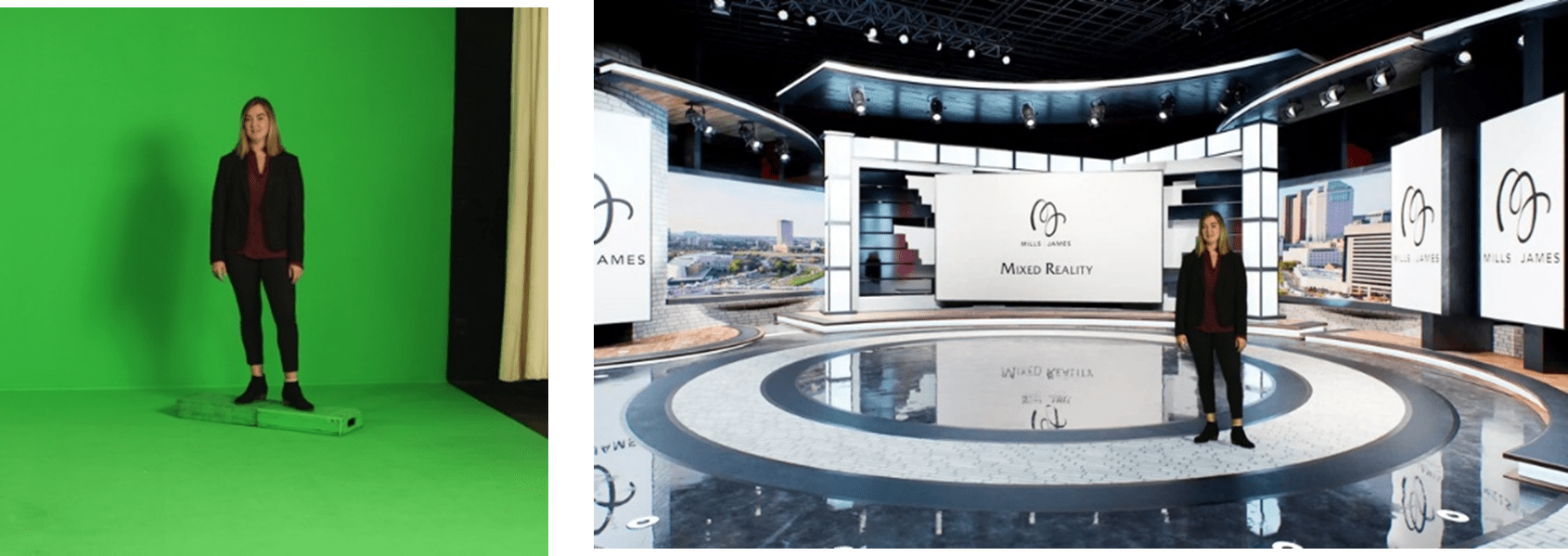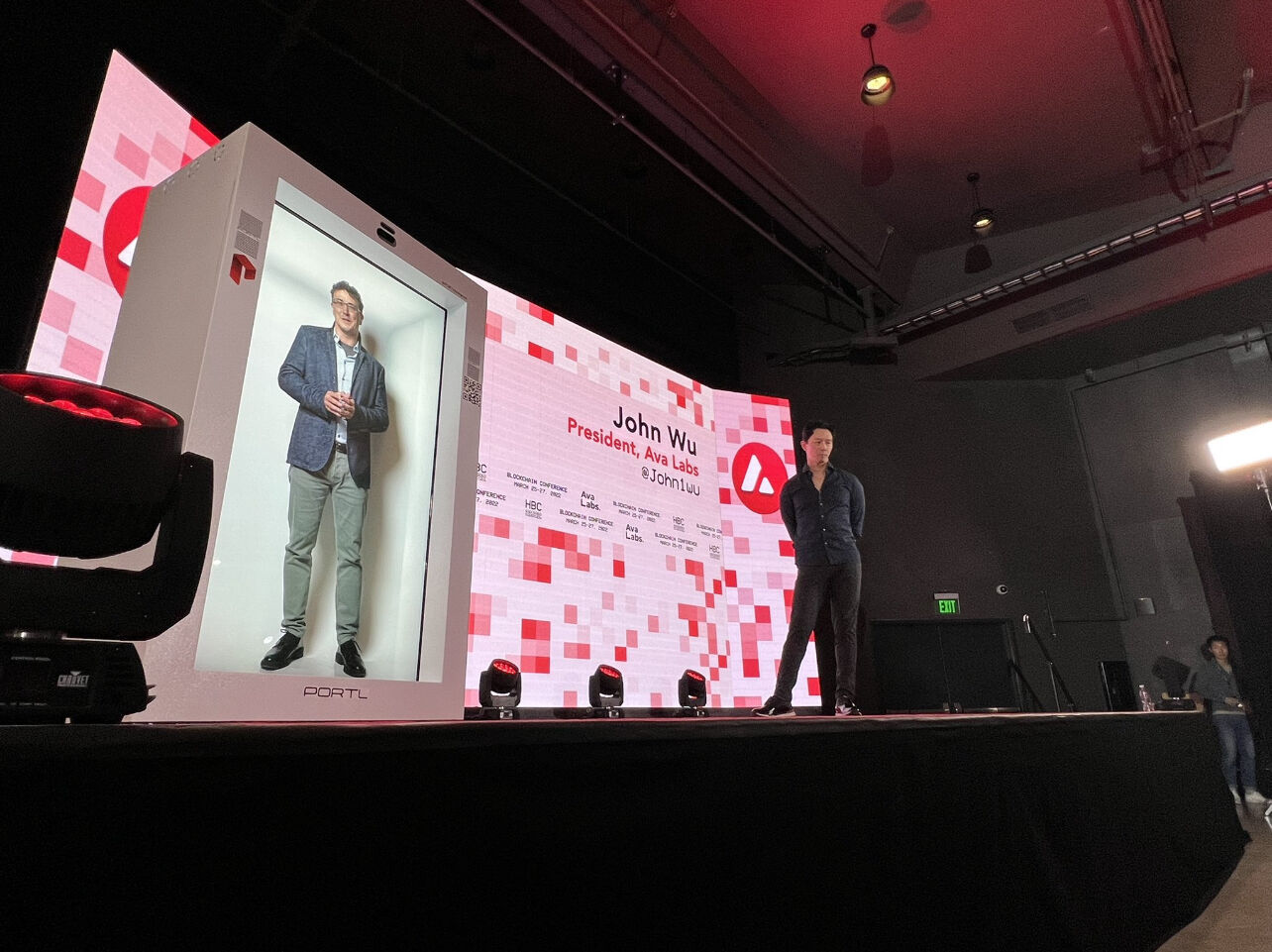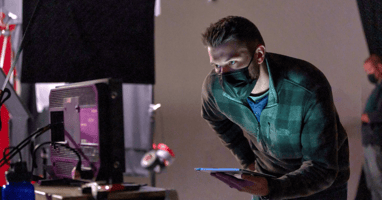Our hospitality AV services group equips hotels with broadcast and streaming technologies to...
The result: It was like they were sitting right next to each other.
2: ‘Think Broadcast’ by creating a broadcast studio and control spaces
In March 2020, our event and video production businesses
collapsed. Faced with this threat, we gathered in the broadcast control room we’d been using for 30 years to produce weekly national newsfeeds with the CNNs and ESPNs of the world. There were video producers, event producers, motion graphic designers, and engineers, each with their individual creative and technical takes. Together we “MacGyvered” all the tech into an entirely new service line: Virtual Events. Overnight, our broadcast studios became virtual broadcast studios, and our single control room blossomed into six control spaces throughout the building.
Where do hospitality venues fit into this new approach? Imagine creating a broadcast studio and control room at your hotel or convention center and offering virtual support to supplement your onsite meeting service line. Think hub and spoke, with event spaces serving as the central meeting hub. Your hotel produces a meeting feed traveling to your clients’ virtual attendees wherever they may be.
The challenge is creative as much as technical. We’ve all sat through dull, poorly executed Zoom meetings (“unmute yourself, Jerry!”) and dry-as-toast PowerPoint webinars. Our teams looked for a far different vision for pandemic engagement — “think broadcast television” — something that has riveted this country since the fifties. The trick is to know how broadcast television glues people to their screens.
Here are Five Rules of Virtual Engagement:
- Narrative impact
- Rapid visual storytelling
- Seamless pacing
- Proof of engagement
- Smart promotion
When you work with an expert in video, broadcast, events, and hospitality AV, hoteliers can leverage the best thinking from all worlds to their property, thereby creating virtual and hybrid experiences for meeting planners and event attendees.

A behind-the-scenes look at the control room for The Avon Company’s multi-day 135th virtual anniversary celebration.
3: Elevate your green screen game
Hospitality venues across the country are creating small greenscreen studios for client use, knowing everyone is itching for greater visual impact than Zoom backgrounds. The good news: a lot of cool green screen-based technology has hit the market since the pandemic, and hospitality venues with studios can sell these advances.

Mills James designer Maddie Riddle is filmed against a green screen (left) and appears in a customized virtual space created through Unreal Engine’s real-time 3D platform.
We’ve been exploring platforms like Unreal Engine. In the image above, you see Mills James designer Maddie Riddle filmed against a green screen in a small studio that could easily be housed at a venue. Most times, she’d be keyed against a flat background waist up, and boom, she’s an evening news anchor. Through Unreal Engine, speakers appear in customized virtual spaces of any size. They can walk around in these spaces while still being filmed in that same small studio. Imagine doing virtual tours of the hotel’s venue space as the images behind you transform.
Hologram technology is another promising development. Executives and VIPs who can’t make events can now beam in with incredibly effective telepresence. PORTL calls it volumetric 4K, and their units have been used for appearances at Emmy broadcasts, reality TV shows, marketing activations, and executive keynotes.
4: Support your physical venue with a digital event platform, especially for training efforts
Many businesses need much richer event platforms than Zoom or WebEx could ever provide. Their events need to have a robust digital presence — before, during, and after — for people to register, browse agendas, read speaker bios, wander through keynotes, attend breakout sessions of their choice, and connect with fellow attendees.
Another big pandemic pivot of ours was researching dozens of these digital event platforms for our clients. We’ve since hired developers and designers to help our clients mirror their physical events in the digital world. It would be wise for hospitality venues to do the same; offer digital solutions that supplement their live events.
This becomes increasingly important when continuing education credits are involved. One of our clients put on an annual in-person multi-day conference with a ton of accredited sessions. When the pandemic hit, we took their entire conference virtual but first had to satisfy the national authority that our virtual CE would meet their standards. It required digital tracking innovations that only a platform could provide.
5: Transform your space with projection innovations
Once the party restarts and group events return in mass, hoteliers will want their spaces to be up to the occasion. Enter projection innovations.
Facilities can transform an atrium into a giant aquarium by mapping video playback to the geography of the space. Images can be projected onto ceiling tents, a dress at a fashion show, photo booths at a holiday party; you name it.

What was once prohibitively expensive (requiring lasers to measure space and days of install) is now more accessible. Again, it’s about seeing a venue for its digital possibilities as much as its physical ones.
AV innovations are here to stay. Virtual and hybrid events may be replacing live shows today, but I’m confident they will stay around to supplement events tomorrow. The silver lining to the COVID-19 pandemic is this: Reaching virtual audiences brings lasting benefits and greater ROI — if you do it right.
Providing conventional AV alone is not enough today. To be competitive and recoup revenues from lost live event business, event operators should partner with a professional AV company that understands how broadcast thinking, digital advances, and immersive innovations elevate a venue’s reputation for delivering extraordinary experiences.



